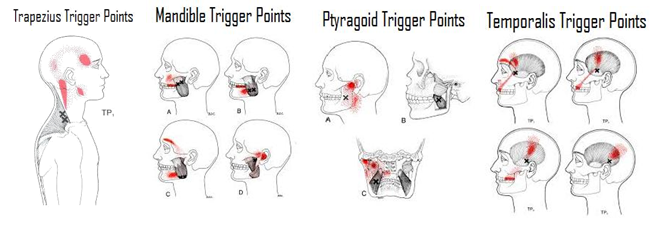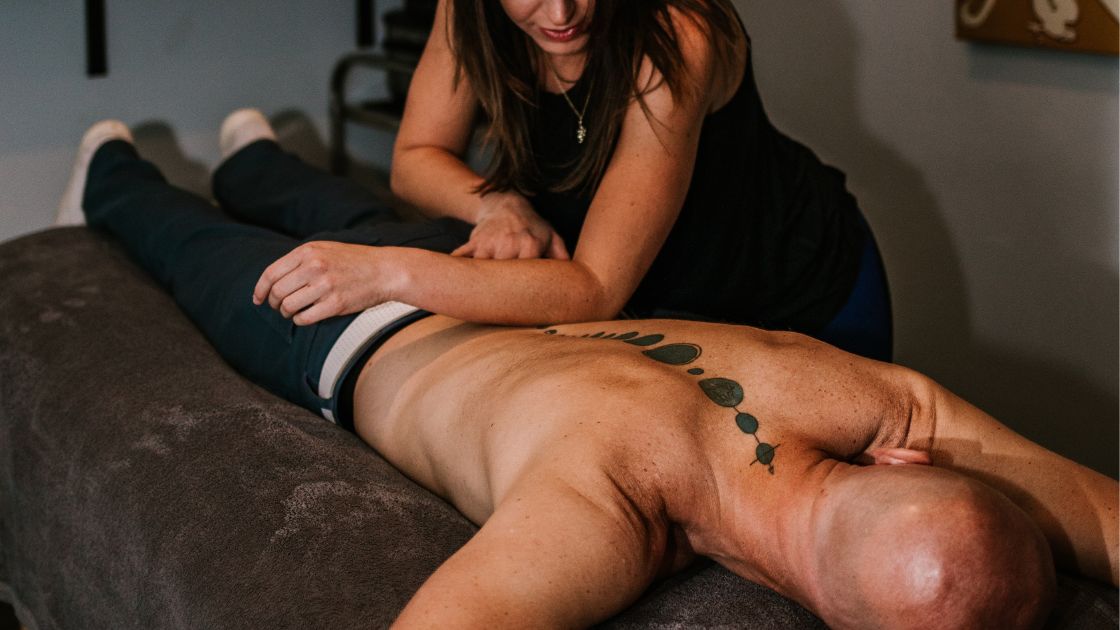Trigger Point Treatment of TMJ

As a massage therapist, I hear the complaints of jaw dysfunction & Temporomandibular Joint Disorders (TMJ / TMD) all the time: jaw pain, popping, bruxism (teeth grinding / teeth clenching), tinnitus (ringing in ears), migraines, headaches, and other associated issues. TMJ and related conditions are often caused by a variety of factors that differ in each person. There are many unique modalities and techniques that can be utilized to address TMJ. One method that stands out as highly effective is Trigger Point Therapy, also sometimes referred to as Neuromuscular Therapy (NMT). It comes as a shock to me that often times when I ask for permission to work on a client’s jaw, their response is: “No one’s done that before!”
What is a trigger point?
Understanding what a trigger point is and how they work in thorough detail requires hours of research and lectures, but it all boils down to one feature- a trigger point is a muscular “knot” or adhesion that refers sensation elsewhere in the body. The referral is usually pain, but trigger points can also refer other sensations including but not limited to tingling, tension, twitching, and itching. The exact mechanism of how trigger points refer pain is widely unknown and debated, but it is well documented that tight, dehydrated muscles deprived of adequate blood flow and oxygen over time do develop trigger points. Trigger points typically refer pain in predictable and similar patterns, which is why we can use Trigger Point Maps as a tool is treating TMJ.
Trigger Points & TMJ Anatomy
When it comes to TMJ dysfunctions, there are a few key muscles we find as major culprits. The first and most superficial muscle is the Mandible, which lifts the jaw upward, as in closing the mouth and clenching teeth. The next, a layer deeper to the mandible, are the Pterygoids, responsible for opening and closing the mouth, as well as sliding the jaw side to side and forward, such as a chewing or a grinding motion. Another muscle I find to be a common factor is the Trapezius. Although it doesn’t directly touch the jaw, trigger points in the trapezius are known to refer pain around the ear and jaw. Temporalis, located just above the ear, can cause pain in the mouth and teeth. Similarly, other neck muscles can refer pain and tension around the mouth, jaw, and head.
The trigger point maps below show common pain referral patterns. The X is where the trigger points are, the red indicated where the discomfort is often felt.
Trigger Point Treatment of TMJ at Moyer Total Wellness
The first step in effective trigger point therapy is finding a therapist that has advanced anatomical knowledge and a complete understanding of trigger point referral patterns. The jaw and face is a personal, sensitive area that should only have therapeutic work done by a licensed, skilled practitioner. Although trigger point therapy can be intense, the results are profound.
The therapist begins by relaxing the muscles before meticulously palpating through tight muscle fibers to locate possible trigger points, which are often small and hidden within ropey muscular bands. Precise, intense pressure is applied directly on the trigger point, which will stimulate and cause the referral pain. As pressure is held, the referral pain will decrease. This treatment is applied for 10-40 seconds in intervals throughout the massage. For optimal results, trigger point therapy should be utilized at least once a month, if not more often for extreme pain, until the referral pain frequency and intensity is greatly reduced or, ideally, completely gone. As a rule, the longer a trigger point has been active, the longer it takes to treat.
I consider Trigger Point Therapy to be my specialty and utilize it in almost all pain management massages at Moyer Total Wellness because it works. There have been instances where I am able to locate a major, active trigger point and the client experienced immediate and long lasting relief. Having hands on, advanced bodywork applied directly to the face and jaw is a crucial step in treating the complex nature of TMJ.
If you wake up with pain in your jaw or teeth, headaches, grinding, or other TMJ-type conditions, massage is a safe, effective, non-invasive, and natural therapy that should be a main component of any treatment plan!
Written By: Hannah Chase Marklinger, LMT
Photo by María Victoria Heredia Reyes on Unsplash






